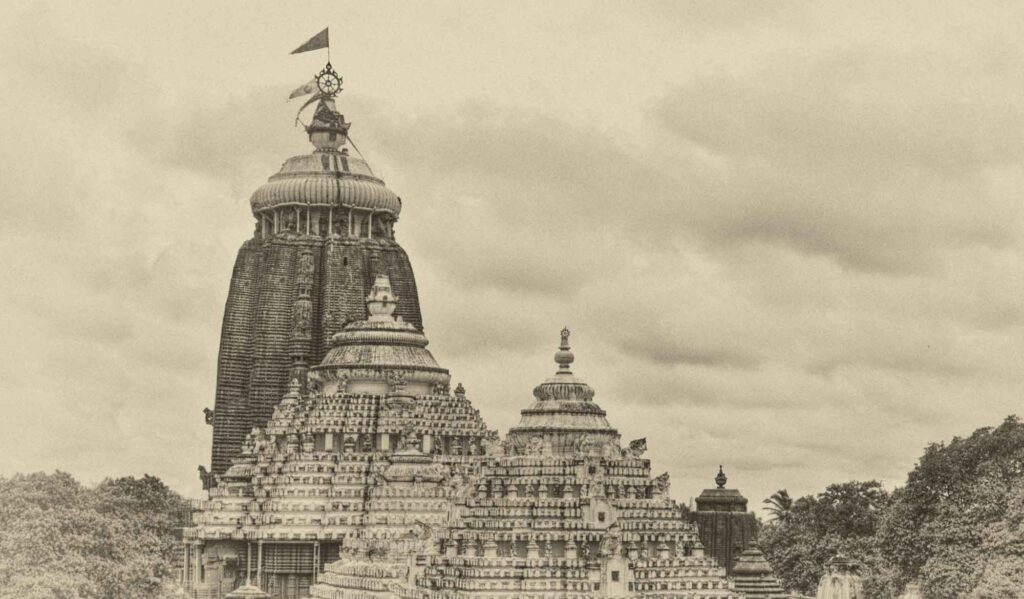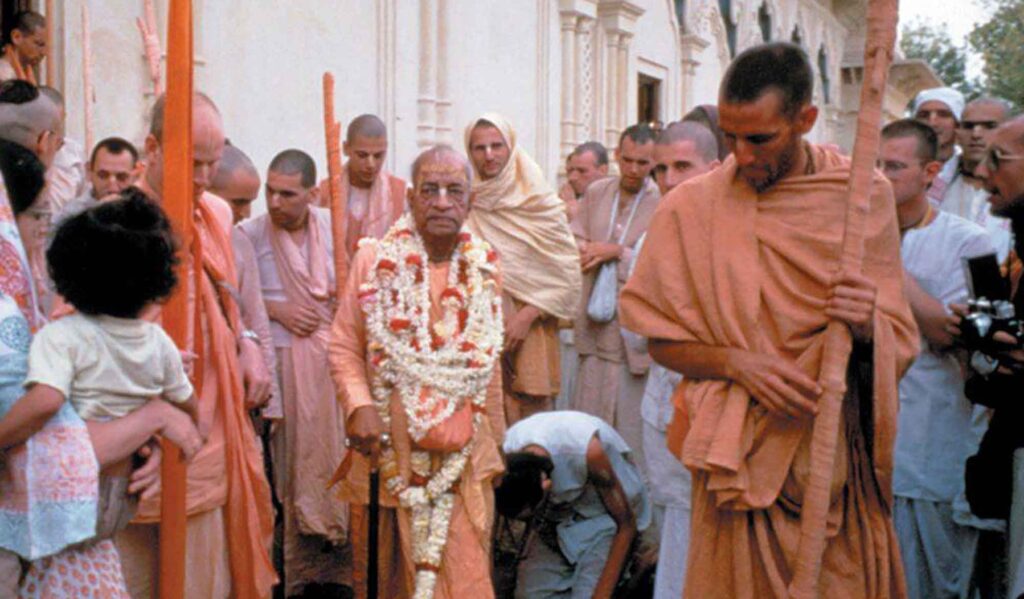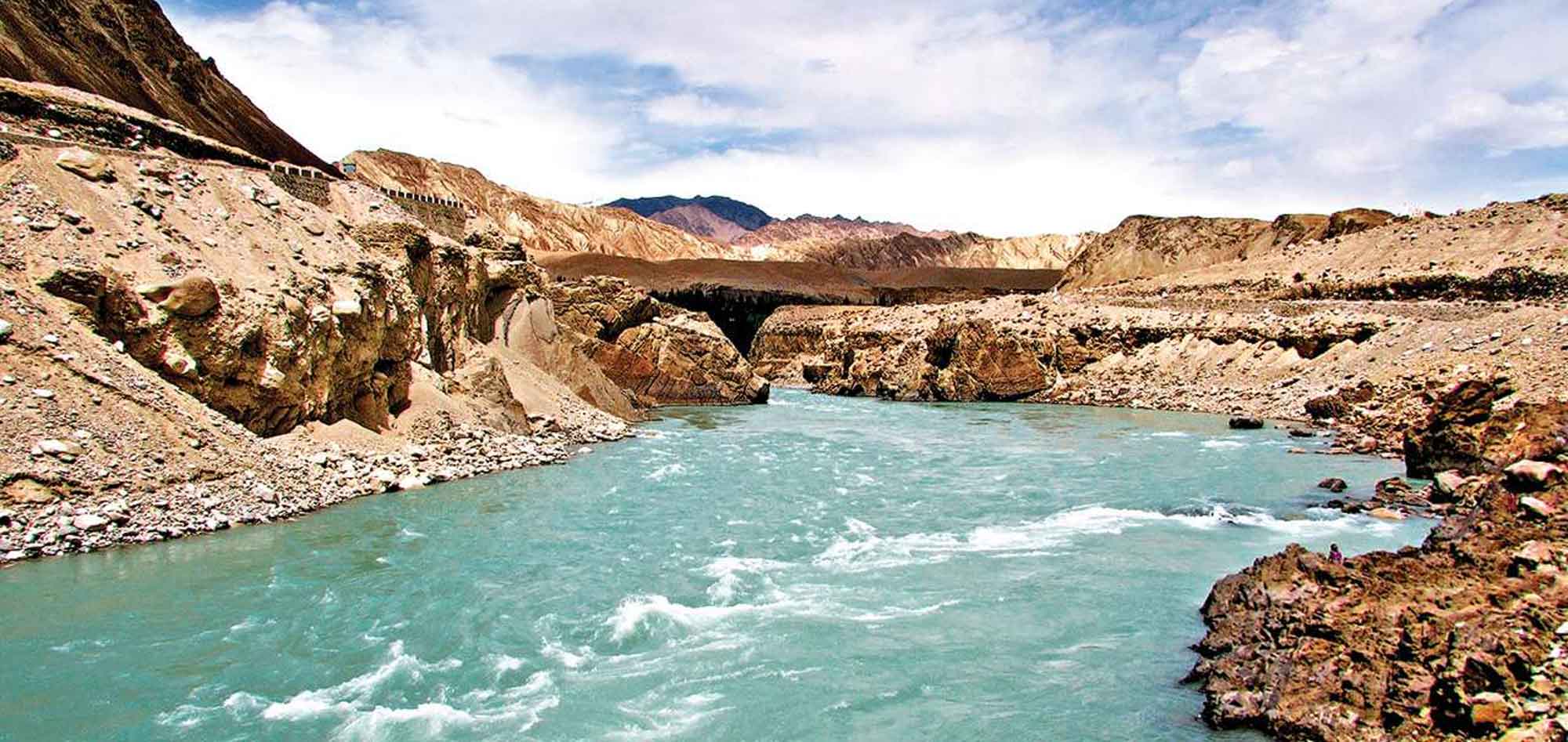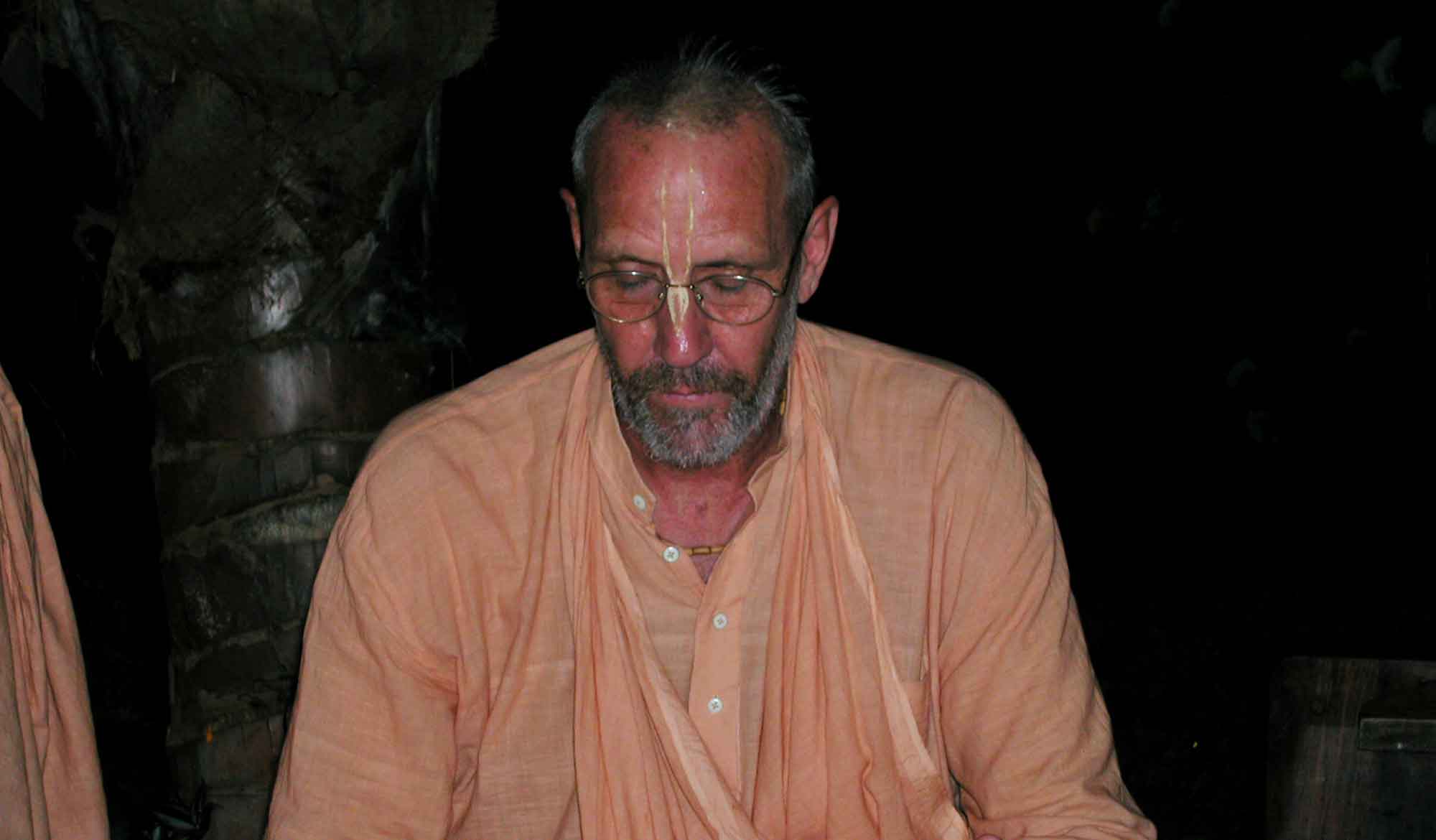by Swami B.G. Narasingha
'Purī Mahārāja's Praṇāma Mantra' was written by Swami B.G. Narasingha on October 12th 2018. Narasingha Maharaja gives a short explanation on the praṇāma mantra, then gives an extensive quote from Śrīla Śrīdhara Mahārāja's book, 'Loving Search for the Lost Servant.'
On the auspicious day of appearance of Śrīla Purī Mahārāja, I received a request from Mukunda Dāsa as follows:
“Today while doing offering and reading the praṇāma-mantra for Śrīla B.P. Purī Mahārāja, it is mentioned, the service of Śrī Purī Mahārāja is just as Śrī Uddhava to Śrī Kṛṣṇa. Very nice to read it and would love to hear more on this, ‘the service of Śrī Purī Mahārāja is just as Śrī Uddhava to Lord Kṛṣṇa’.
Śrīla Bhakti Pramoda Purī Mahārāja’s praṇāma-mantra is as follows:
nama oṁ viṣṇu-pādāya gaura-preṣṭhāya bhū-tale
śrīmad bhakti-pramodāya purī gosvāmīnīti nāmine
“I offer my obeisance unto Oṁ Viṣṇupada Śrīla Bhakti Pramoda Purī Gosvāmī, who is most dear to Śrī Gaura in this world.”
divya-jñāna pradātra ca prabhave janma janmani
jñāna-vairāgya-dehāya śāstra-siddhānta samvide
“Birth after birth, may he always bestow and enlighten me with divine knowledge. He is the personification of spiritual wisdom and is the revealer of the conclusions of śāstra.”
patitānām samuddhāre yati-veśa dharāya vai
pracārācāra karye ca jagarukāya sarvadā
“He has accepted the robes of a sannyāsī in order to deliver the fallen souls. He is always attentive to both devotional practice and preaching.”
yathoddhavasya-kumārad bhagavadārcane rati
vaiṣṇavānām sarva kṛtye dakṣata paramā tathā
“In his youth, he developed an attraction towards the worship of the Supreme Lord, in the same way that Śrī Uddhava did. He is supremely expert in all the devotional ceremonies of the Vaiṣṇavas.”
My reply was as follows:
Uddhava is known as the dear most and intimate friend of Lord Kṛṣṇa. So much so that Kṛṣṇa says,
na tathā me priyatama ātma-yonir na śaṅkaraḥ
na ca saṅkarṣaṇo na śrīr naivātmā ca yathā bhavān
“O Uddhava! Neither Brahmā nor Śiva are as dear to Me as you; My elder brother Saṅkarṣaṇa is not as dear to Me as you, nor even Lakṣmī. Even My own Self is not as dear to Me as you.” (Bhāg.11.14.15)
From the very beginning of his life, even as a young boy, Śrīla Purī Mahārāja manifested great attachment towards Lord Kṛṣṇa. Śrī Uddhava carried a message from Kṛṣṇa to the gopīs in Vṛndāvana and upon his return, he announced that above all, the gopīs were the greatest devotees of Kṛṣṇa. Similarly, in his adult life, Śrīla Purī Mahārāja carried the message of kṛṣṇa-bhakti to the world and announced that the greatest devotees of Kṛṣṇa are the gopīs of Vṛndāvana and among the gopīs, the topmost position is held by Śrīmatī Rādhārāṇī. Praising the gopīs as the greatest devotees, Uddhava prayed to take birth as a blade of grass in Vṛndāvana so that he may be trampled upon by the lotus feet of the gopīs. Śrīla Purī Mahārāja also had such sentiments towards Vṛndāvana and the gopīs.
āsām aho caraṇa-reṇu-juṣām ahaṁ syāṁ
vṛndāvane kim api gulma-latauṣadhīnām
yā dustyajaṁ sva-janam ārya-pathaṁ ca hitvā
bhejur mukunda-padavīṁ śrutibhir vimṛgyām
“The gopīs of Vṛndāvana gave up their husbands, children, and families who are difficult to renounce, and sacrificed even their religious principles to take shelter of the lotus feet of Kṛṣṇa, which are sought after even by the Vedas themselves. O! Grant me the fortune to take birth as a blade of grass in Vṛndāvana, so that I may take the dust of the lotus feet of those great souls upon my head.” (Bhāg. 10.47.61)
As Caitanya Mahāprabhu has suggested, Gauḍīya Vaiṣṇavas accept the Bhāgavatam as the topmost pramāṇa (evidence).
In the 10th canto of the Bhāgavatam, we are taken to the highest conception of divinity and shown who are the greatest devotees of Kṛṣṇa. In the conception of other sampradāyas, Lakṣmī, the Four Kumāras, Śiva, Candrāvalī and others are conceived as holding the highest position, but Bhāgavatam dismisses all in front of the vraja-gopīs and heralds Śrīmatī Rādhārāṇī as the topmost devotee. Indeed, Śrīmatī Rādhārāṇī is the full embodiment of mahābhāva, of the hlādhinī-śakti, the internal pleasure potency of Kṛṣṇa.
The following is an excerpt from Loving Search for the Lost Servant by Śrīla B.R. Śrīdhara Mahārāja proclaiming the glories of Śrīmatī Rādhārāṇī, rādhā-dāsyam, in the Gauḍīya Vaiṣṇava conception:
Once, the Diwān of Bhāratpur had come on a pilgrimage with his family to the holiest of places, Śrī Rādhā-kuṇḍa, the holy lake of Śrīmatī Rādhārāṇī. He and his family were circumambulating Rādhā-kuṇḍa. They would fall flat on the ground, offering obeisances lying down with their arms outstretched. Every time they bowed down in this way, they would mark the spot where their fingertips touched the earth. Then they would slowly rise, step forward to where that spot had been marked, and again fall flat, offering their obeisances with great respect and adoration. In this way they were circumambulating the entire Rādhā-kuṇḍa. Upon seeing such intense worship, Paramānanda Prabhu, an intimate disciple of our Guru Mahārāja Śrīla Bhaktisiddhānta Sarasvatī Ṭhākura, intimated to Prabhupāda that the Diwān and his family must have great respect for Rādhārāṇī to circumambulate the Rādhā-kuṇḍa in such a fashion.
At that time Prabhupada said, “Their angle of vision towards Rādhā-kuṇḍa and Rādhārāṇī is different from ours. They recognise and revere Kṛṣṇa. And because Rādhārāṇī is Kṛṣṇa’s favourite, they also have some reverence for Rādhā-kuṇḍa. But our vision is just the opposite. Our concern is with Rādhārāṇī. And only because She wants Kṛṣṇa do we have any connection with Him.”
And so, the Gauḍīya Vaiṣṇavas know only Rādhārāṇī. They are concerned only with Her, and Her duties, Her necessities. They are ready to serve Her in all respects, and cannot contemplate any service without Her. That is the highest achievement of the Gauḍīya Vaiṣṇavas, that is the special feature of Mahāprabhu’s party, and that was announced by Raghunātha Dāsa Gosvāmī in his Vilāpa-kusumāñjali (102):
āśā-bharair amṛta-sindhu-mayaiḥ kathañcit
kālo mayātigamitaḥ kila sāmprataṁ hi
tvaṁ cet kṛpāṁ mayi vidhāsyasi naiva kiṁ me
prāṇair vrajena ca varoru bakāriṇāpi
This verse is a direct prayer to Rādhārāṇī. It expresses a particular type of hope which is so sweet and reassuring that it is compared with an unlimited ocean of nectar. He says, “There is a hope which is sustaining me and nurturing my existence. With that hope I am somehow passing my days, dragging my life through these tedious times. That nectarine ocean of hope is attracting me and keeping me alive. But my patience has reached its end. I can’t endure it any longer. I can’t wait any more.”
“At this moment if You do not show Your grace to me, I am finished. I shall lose my prospect forever. I shall have no desire to continue my life. It will all be useless. Without Your grace, I can’t stand to live another moment. And Vṛndāvana, which is even dearer to me than my life itself -I am disgusted with it. It is painful; it is always pinching me. And what to speak of anything else, I am even disgusted with Kṛṣṇa. It is shameful to utter such words, but I can have no love even for Kṛṣṇa unless and until You take me within Your confidential camp of service.” This is the prayer of Raghunātha Dāsa.
When Śrīla Bhaktisiddhānta Sarasvatī Prabhupāda would begin to explain this verse, his figure would become transformed. He would become full of emotion; his face would become like that of a phantom.
In this verse, Raghunātha Dāsa Gosvāmī, taking an extreme risk, says, “O Rādhā, if I do not get Your favour, I don’t want anything. I want You and You alone. To have an independent relationship with anyone else, eliminating You, is impossible in my life. You must be first, and then others. Without You, we can never even think of a separate relationship with Kṛṣṇa.”
Bhaktivedānta Swami Mahārāja has written that without Rādhārāṇī’s company, Kṛṣṇa is not beautiful. Everything is relative-dependent. A teacher depends on the student, and the student depends on his teacher. Although Kṛṣṇa is the enjoyer, He is completely dependent on the enjoyed, Śrīmatī Rādhārāṇī. The two are correlative; one cannot be separated from the other. As the enjoyed, Rādhārāṇī is also absolutely dependent on Kṛṣṇa, the enjoyer.
Rādhārāṇī says, “My fate is lost forever because I have given Myself, I have sold Myself to many places. When I heard the flute, I dedicated Myself to the song of the flute. When I heard the name of Kṛṣṇa, I dedicated Myself to that sound. And when I saw a beautiful picture of Kṛṣṇa, I wholly dedicated Myself to that picture. So in three places I have sold Myself completely, with no possibility of any happiness or peace in My life. If l had dedicated Myself to only one thing, there might have been a possibility of peace, but because I have dedicated Myself in three different places, I am hopeless.
“Seeing the picture of Kṛṣṇa, I couldn’t contain Myself. I couldn’t but give Myself to that beautiful figure, and so I dedicated Myself fully. The name of Kṛṣṇa also purchased Me fully. And the sweet sound from the flute – that has also drawn Me to the extreme of dedication. So how can I hope for peace in My life? It is impossible, My friends.” Rādhārāṇī did not know it at that time, but the source of Kṛṣṇa’s flute, His name, and His beauty are one. If She could have seen how all three of these meet together, then it would have been possible for Her to have peace of mind. But it is difficult to understand this principle.
How is it that the sound of Kṛṣṇa’s flute, the sound of His name, and a picture of His form are non-different from Kṛṣṇa Himself? Idealism. In Hegel’s words, ideal realism. The absolute idea is not to be dismissed as an abstract thing; rather, it is the basis of all existence. Reality is there, but it is ideal realism. And the foundation of the reality of Vṛndāvana is given by Nityānanda, Baladeva: nitāiyera karunā habe, vraje rādhā-kṛṣṇa pābe, dhara nitāi-caraṇa du’khāni.
After Bhaktivinoda Ṭhākura describes the position of Rādhārāṇī in his Śaraṇāgati, he says, “I want to serve those who have the service of Rādhārāṇī in their heart. I want to serve the feet-dust of those whose only wealth is the service of Śrī Rādhā. I want to fall before them and take the dust of their holy feet. If you cannot fix your mind in the service of Rādhārāṇī, then all your attempts to serve Kṛṣṇa are useless. If you cannot achieve earnestness in the service of Śrīmatī Rādhārāṇī, then all your labour for Kṛṣṇa has gone to hell.” We cannot conceive of a sun without heat, nor can we conceive of Godhead without His potency. So also, no conception of Kṛṣṇa is possible without Śrīmatī Rādhārāṇī. We can’t know any Mādhava without Rādhā.
She is Kṛṣṇa’s other half, in Śrīla Bhaktisiddhānta’s language, the predominated moiety. Devotional service as a whole is represented by Her, because both the intensity and the comprehensiveness of Her service to Kṛṣṇa are unparalleled. There are so many examples of chaste and pious ladies in the ancient history of the Purāṇas: Śacī, the faithful wife of Indra; Sati, the wife of Lord Śiva; Lakṣmī Devī, the goddess of fortune; Satyabhāmā, Kṛṣṇa’s wife in Dvārakā; Rukmiṇī, the principle queen of Kṛṣṇa in Dvārakā; and even the antagonists of Rādhārāṇī, headed by Candrāvalī. All of them represent different aspects of Rādhārāṇī. They all spring from the main potency which is known as Rādhā.
The name Rādhā comes from the word arādhanīya: One who can serve, who can worship, who can give respect, who really loves Kṛṣṇa, who can render loving service. All of these other ladies who are famous for their chastity and piety are but partial representations of Rādhārāṇī. If we note the scriptures and scrutinize the position of those virtuous ladies, we’ll find that the source of all their chastity and devotion is Śrīmatī Rādhārāṇī. She is the fountainhead of devotion. And so Bhaktivinoda says, “I bow down and take the dust of the holy feet of those who have as their only wealth the service of Rādhārāṇī. I hanker after nothing else.” Whoever knows this and always travels on that path with a sincere heart is most fortunate.
It is the ideal that makes one great, not any material possession. One who has the highest ideal is really wealthy. The highest ideal is the most valuable thing we may possess. And less valuable things must be eliminated if we are to concentrate our efforts and save ourselves from useless endeavour. Caitanya Mahāprabhu came to show us that highest ideal – the path of divine love. And we find divine love of Godhead in its highest intensity in His life and teachings of Śrīmad Bhāgavatam. The whole Śrīmad Bhāgavatam is meant to illustrate the ideal of divine love which reaches its highest expression in Śrīmatī Rādhārāṇī.
The Śrīmad Bhāgavatam sings very gloriously about the paramour relationship of Rādhā and Kṛṣṇa. The Vedas and other Purāṇas are not so expressive about such confidential pastimes, yet we find a hint of the glories of Rādhā and Kṛṣṇa in Śrīmad Bhāgavatam. And the Gosvāmīs have more fully expressed Rādhārāṇī’s devotion in their writings. In Rūpa Gosvāmī’s Padyāvalī, we find Her saying, “My Lord, people say that I have a bad reputation because of My connection with You. I do not feel any trouble in My heart because of this. My concern is that I could not give Myself to You completely. The people in general say that I am illicitly connected with You, but what disturbs Me is that I could not really give Myself to You. I feel that I am not fit for Your service. This is only the trouble within My heart.”
And the ecstasy of divine love increases in separation. One day, when Kṛṣṇa was playing with His cowherd boyfriends in the pasturing grounds of Vṛndāvana, Kṛṣṇa suddenly felt extreme separation from Rādhārāṇī. He sent His best friend Subala to Rādhārāṇī, saying, “Go to My Rādhā and fetch Her. Without Her, I can’t live. Suddenly I have so much desire for Her company that I can’t stand it anymore. Somehow manage to bring Her.”
Subala said, “How is it possible to bring Her here in the jungle in broad daylight?” Kṛṣṇa told him, “Somehow manage it!”
Subala thought, “What should I do?” Subala was very intimately connected with the family of Rādhārāṇī’s husband. He went to the house of Rādhārāṇī and told Her girlfriends, “Kṛṣṇa can’t tolerate separation from Rādhārāṇī any longer. He is so eager to meet Her that He is going mad. Somehow you have to arrange for Them to meet.”
“How is it possible?” the gopīs asked. Subala explained to them that Kṛṣṇa was nearby in the jungle. They discussed between themselves what to do. Subala was a beautiful boy who resembled Rādhārāṇī. So Subala took the dress of Rādhārāṇī, and Rādhārāṇī wore Subala’s cowherd dress.
When Rādhārāṇī was discovered wearing the dress of Subala, She was challenged by Her family members: “Subala! What are you doing here?” In the dress of Subala, Rādhārāṇī said, “A calf is missing and its mother is mooing. So I have come here looking for that calf.” So a calf was given to Rādhārāṇī, and She carried that small calf on her breast into the forest. In this way, Rādhārāṇī was disguised as Subala, while Subala, who had taken the dress of Rādhārāṇī, remained behind in Her room.
Rādhārāṇī had been given a hint of where Kṛṣṇa was hiding near the forest’s edge. She went to seek Him out. At last, when Rādhārāṇī saw Kṛṣṇa, She approached Him in the garb of Subala. Kṛṣṇa was mad. He could not detect that Rādhārāṇī had come, but mistook Her for Subala. He said, “Oh, Subala, you have come back without Rādhārāṇī! Couldn’t you bring Her?”
Rādhārāṇī began cutting jokes: “No,” She said, “It was impossible for me to bring Her in the daytime.” Kṛṣṇa said, “Then what am I to do? I can’t tolerate My life any longer.”
Rādhārāṇī said, “If You say so, I can go to Candrāvalī and bring her.”
“No, no,” Kṛṣṇa said, “Curd cannot satisfy the thirst for milk. It is not possible!”
Kṛṣṇa was faint with disappointment. Then Rādhārāṇī embraced Him, saying, “My Lord, can’t You recognise Your maidservant? You failed to recognise Me!” Then Kṛṣṇa was again full of joy.
Although the pastimes of Rādhā and Govinda are mentioned in the scriptures, these are all very high things. They are not ordinarily to be expressed in words, but still sometimes we are forced to speak about them because the high ideal of divine love given by Śrīmad Bhāgavatam is the supreme goal of life. Of course, the scholarship of Śukadeva Gosvāmī and Srl Gaurāṅga Mahāprabhu have helped, to a certain extent, to establish the dignity of the proposal that love is above knowledge. It was admitted by everyone that Śukadeva held the highest attainment of the learned men of knowledge; he was unanimously admitted by the scholars to hold the highest position. Because of this, when Śukadeva Gosvāmī came to inaugurate the principle that divine love is above everything else, the scholars had to take notice. Caitanya Mahāprabhu demonstrated to the scholars that His intelligence and scholarship excelled everyone else’s. So when He came with the tidings of divine love, then it was easier for the ordinary men to accept it as the highest ideal and try for it.
So Vāsudeva Ghoṣa says, yadi gaura nā haite, tabe ki haita kemane dharitām de. If Mahāprabhu had not appeared in this Kali-yuga, then how could we tolerate living? How could we sustain our lives? What He has given -the very gist of life, the very taste, the charm of life – without that, we think it is impossible for anyone to live in this world. Such a thing has been invented, discovered by Gaurāṅga. If He had not come, then how could we live? It is impossible to live devoid of such a holy and gracious thing as divine love. Without Caitanya Mahāprabhu, how could we know that Rādhārānī stands supreme in the world of divine love? We have received all these things from Him, and now we think that life is worth living. Otherwise to live would be suicidal.
And serving those who can serve Rādhārāṇī is the way to approach Her vicinity. By serving the servants of the servants, we are assured of success in getting the grace of Kṛṣṇa. If somehow one can be counted in the group of Śrīmatī Rādhārāṇī’s servitors, one’s future is assured.
Within the group of Rādhārāṇī’s servitors, we aspire to be Rūpānugas, followers of Śrī Rūpa. And the followers of Śrī Rūpa will have great earnestness to look after the order of Śrī Rūpa, as he does towards Lalitā. In this way, through Rūpa Gosvāmī, our devotional service is going to the highest plane. And our highest gain is only there. Not even our connection with Rādhārāṇī or Lalitā Devī is the highest goal of life, but our highest aspiration is to serve in the Rūpānuga sampradāya; that means that our highest attainment is in Śrī Rūpa’s connection.
Rādhā-dāsyam has been said to be the highest attainment. Why? The quality and quantity of rasa that Rādhārāṇī can draw from Kṛṣṇa can never be found anywhere else. So if you are situated just behind Rādhārāṇī, you’ll be allowed to taste not only the quantity, but the highest quality of rasa.
No other person can draw such high rasa from Kṛṣṇa. The fullest, highest type of quality is drawn from Kṛṣṇa: He gives Himself fully and wholly and deeply. So if you are in Śrī Rūpa’s group, then you can have a taste of that sort of rasa.
In Rādhārāṇī’s camp, when Kṛṣṇa and Rādhā are enjoying very solitary pastimes in a secluded place, the grown-up sakhīs can’t venture to enter the room and assist Them. The young girls, the mañjarīs, are sent there. The leader of that young group can enter where both Rādhā and Govinda are very closely connected, when even the sakhīs do not venture to go for fear of causing some interruption. But Rūpa and the mañjarīs can enter there at that time due to their young age. That sort of rasa that cannot be had even through the sakhīs can be had only through the mañjarīs.
Bhaktivinoda Ṭhākura prays to gain admission there. He has such a high quality of aspiration. He says, rūpānuga haite sei dayā. He runs to be enlisted in the group of Rūpa, who can grant us that sort of prospect. And Prabhodānanda Sarasvatī has described the prerequisite for understanding all these things:
yathā yathā gaura-padāravinde
vindeta bhaktiṁ kṛta-puṇya-rāśiḥ
tathā tathotsarpati hṛdy akasmāt
rādhā-padāmbhoja-sudhāṁbu-rāśiḥ
“As much as you surrender to the lotus feet of Śrī Gaurāṅga, you’ll find yourself safely situated in the service of Rādhā-Govinda. Don’t try to approach Rādhā-Govinda directly; if you do, there may be some difficulty. But the lotus feet of Śrī Gaurāṅga will take you there safely.”
In my Sanskrit poem dedicated to Bhaktivinoda Ṭhākura, I have explained all these points:
śrī-gaurānumataṁ svarūpa-viditaṁ rūpāgrajenādṛtaṁ
rūpādyaiḥ pariveśitaṁ raghu-gaṇair āsvāditaṁ sevitam
jīvādyair abhirakṣitaṁ śuka-śiva-brahmādi-saṁmānitaṁ
śrī-rādhā-pada-sevanāmṛtam aho tad dātum īśo bhavān
“What was sanctioned by Śrī Caitanya Mahāprabhu by His descent was intimately known only to Śrī Svarūpa Dāmodara Gosvāmī. It was adored by Sanātana Gosvāmī and served by Rūpa Gosvāmī and his followers. Raghunātha Dāsa Gosvāmī tasted that wonderful thing fully and enhanced it with his own realization. And Jīva Gosvāmī supported and protected it by quoting the scriptures from different places. The taste of that divine truth is aspired for by Brahmā, Śiva, and Uddhava, who respect it as the supreme goal of life. What is this wonderful truth? Śrī-rādhā-pāda-sevana – that the highest nectar of our life is the service of Śrīmatī Rādhārāṇī. This is most wonderful. O Bhaktivinoda Ṭhākura, you are our master. It is within your power to allow them to bestow their grace upon us. You are in a position to bestow the highest gift ever known to the world upon us all. It is at your disposal. O Bhaktivinoda Ṭhākura, please be kind to us and grant us your mercy.”
So Śrī Caitanya Mahāprabhu, our most benevolent Lord, has come to search for His long lost servants and to give to them this highest ideal of divine love. Gaura-haribol!
More Articles by Swami B.G. Narasingha
The Sacred River Sindhu/Indus
‘The Sacred River Sindhu/Indus’ was posted by Swami B.G. Narasingha on his blog, narasingha.net, on October 2nd, 2011. In this short article, Narasingha Maharaja explains the significance of the River Sindhu and his pilgrimage to it. This article was later expanded into a bigger article called ‘Sindhu River – How India Got Her Name.’
Instructing the Guru
This article “Instructing the Guru” was written in April 2018 by Śrīla Narasingha Mahārāja who answers a question concerning a previous article wherein a Vaiṣṇavī writes a letter to her dīkṣā-guru and explains to him about the importance of śikṣā. In response, a question was raised by a devotee about the etiquette of a disciple instructing her guru.
The Atomic Ray – From Uniform Consciousness to Individual Conscious Units
In “The Atomic Ray - From Uniform Consciousness to Individual Conscious Units” written in 1996 Śrīla Narasiṅgha Mahārāja discusses the constitutional position of the jīva, according to Bhaktivinoda Ṭhākura and Śrī Caitanya-caritāmṛta.













